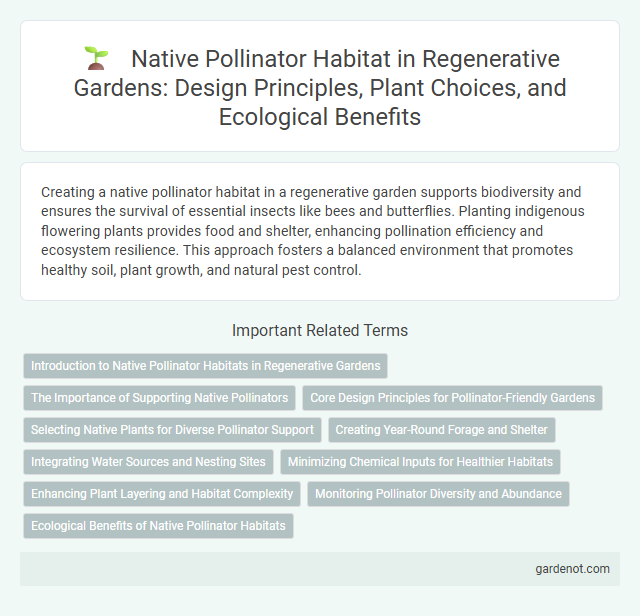Creating a native pollinator habitat in a regenerative garden supports biodiversity and ensures the survival of essential insects like bees and butterflies. Planting indigenous flowering plants provides food and shelter, enhancing pollination efficiency and ecosystem resilience. This approach fosters a balanced environment that promotes healthy soil, plant growth, and natural pest control.
Introduction to Native Pollinator Habitats in Regenerative Gardens
Native pollinator habitats in regenerative gardens support biodiversity by providing essential resources such as nectar, pollen, and nesting sites for bees, butterflies, and other pollinating insects. These habitats include native flowering plants, undisturbed soil, and natural ground covers that promote pollinator health and resilience. Integrating native pollinator species enhances ecosystem services, improves plant reproduction, and contributes to sustainable garden productivity.
The Importance of Supporting Native Pollinators
Supporting native pollinators is vital for maintaining biodiversity and ecosystem health in regenerative gardens. Native pollinators such as bees, butterflies, and beetles enhance plant reproduction by facilitating effective pollination, which boosts crop yields and wild plant diversity. Creating habitats with native flowering plants, nesting sites, and shelter promotes pollinator populations, ensuring long-term ecological balance and resilience.
Core Design Principles for Pollinator-Friendly Gardens
Native pollinator habitats thrive when gardens integrate diverse, native flowering plants that provide continuous blooms throughout the growing season, ensuring abundant nectar and pollen sources. Incorporating layered vegetation structures, including ground covers, shrubs, and trees, creates essential shelter and nesting sites for a variety of pollinator species such as bees, butterflies, and hummingbirds. Maintaining chemical-free soil and minimizing disturbance further supports pollinator health by preserving soil microbiota and breeding environments critical to sustainable ecosystem function.
Selecting Native Plants for Diverse Pollinator Support
Selecting native plants like milkweed, coneflowers, and goldenrod creates a diverse pollinator habitat that supports bees, butterflies, and hummingbirds. These species provide essential nectar and pollen sources throughout the growing season, enhancing biodiversity and ecosystem resilience. Prioritizing native flora helps sustain local pollinator populations and promotes natural regeneration in garden ecosystems.
Creating Year-Round Forage and Shelter
Establishing a native pollinator habitat involves planting diverse, indigenous flowering plants that bloom sequentially throughout the year, ensuring continuous forage for pollinators like bees, butterflies, and hummingbirds. Incorporating native shrubs, grasses, and groundcovers provides essential shelter and nesting sites, supporting pollinator life cycles and enhancing biodiversity. This regenerative approach improves ecosystem resilience and promotes sustainable pollination services within the garden environment.
Integrating Water Sources and Nesting Sites
Integrating water sources and nesting sites within native pollinator habitats enhances biodiversity and supports the lifecycle of essential pollinator species such as bees, butterflies, and hummingbirds. Providing shallow water features alongside diverse natural nesting materials like hollow stems, bare soil patches, and wood cavities encourages sustained pollinator presence and improves pollination efficiency. This holistic approach in regenerative gardens strengthens ecosystem resilience and promotes healthy plant reproduction.
Minimizing Chemical Inputs for Healthier Habitats
Minimizing chemical inputs in native pollinator habitats enhances biodiversity by preserving beneficial insect populations and promoting natural pest control. Employing organic mulches, compost teas, and physical barriers reduces reliance on synthetic pesticides and herbicides, safeguarding pollinator health. Healthy, chemical-free environments increase native plant resilience and support robust pollination cycles essential for regenerative garden sustainability.
Enhancing Plant Layering and Habitat Complexity
Enhancing plant layering in a native pollinator habitat increases biodiversity by providing diverse microhabitats and food sources essential for pollinator survival. Incorporating a variety of native shrubs, wildflowers, and ground covers creates structural complexity that supports different pollinator species at various life stages. This multi-layered vegetation improves ecosystem resilience and promotes effective pollination, contributing to the overall health of a regenerative garden.
Monitoring Pollinator Diversity and Abundance
Monitoring pollinator diversity and abundance in a native pollinator habitat involves regular surveys and identification of key species such as native bees, butterflies, and hoverflies. Using standardized methods like transect walks and pan trapping helps track population trends and habitat health in the regenerative garden. Data collected supports adaptive management practices to enhance floral resources and nesting sites, promoting ecosystem resilience and biodiversity.
Ecological Benefits of Native Pollinator Habitats
Native pollinator habitats support crucial ecological processes by enhancing plant reproduction and promoting biodiversity, which maintains ecosystem stability. These habitats increase the resilience of local flora through specialized pollination, aiding in the production of fruits, seeds, and food sources for wildlife. Conserving native plants within pollinator habitats also improves soil health and water retention, contributing to a sustainable regenerative garden ecosystem.
Native pollinator habitat Infographic

 gardenot.com
gardenot.com